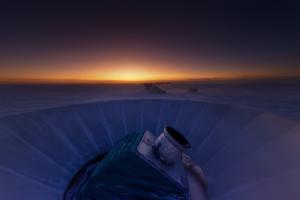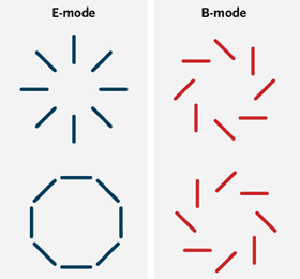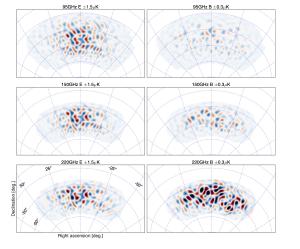Blog
So Mode It B
23 October 2021
 Steffen Richter, Harvard University
Steffen Richter, Harvard UniversityThe standard model of cosmology is a remarkably powerful and accurate description of the universe, tracing its evolution from the big bang to its current state, but it is not without mysteries. One of the biggest unsolved questions of the standard model is known as early cosmic inflation.
The idea is that in the earliest moments after the big bang, the universe had an intense snap of expansion. Spatial distances on the order of a nanometer expanded to more than 10 light-years in a tiny fraction of a second. It’s a wild idea but is widely accepted among cosmologists. For one, we know that cosmic expansion is real because we observe it in the current universe. For another, early cosmic expansion would explain three important facts about the universe. It is observed to be spatially flat on large scales, it’s background temperature is extremely uniform, and we haven’t observed some strange physics such as magnetic monopoles.
But just because a model makes sense, that doesn’t make it true. While early cosmic expansion has a great deal of theoretical support, there is currently no observational confirmation of it. Finding observations to support it has proven extremely difficult. So difficult that several years ago one large study known as BICEP2 caught itself up in some level of controversy.
 Sky and Telescope
Sky and TelescopeThe BICEP Collaboration is an Antarctica-based telescope that observes light from the cosmic microwave background. Light from the cosmic background is polarized, meaning that it has an orientation. On a large scale, this polarization can take on two forms: E-mode and B-mode polarization. BICEP looks for B-mode polarization because that’s the mode that can be caused by primordial gravitational waves caused by early cosmic expansion. According to the theory, the early snap of inflation was like ringing a cosmic bell, and its gravitational waves still echo across the universe. These waves can twist polarized light into a B-mode orientation.
The problem is that B-mode polarization can also be caused by other effects, such as gravitational lensing and interstellar dust. In 2014 BICEP2 announced they had discovered B-mode evidence of cosmic inflation, but then had to walk back their claims to be more tentative. The upshot of BICEP2 was that the results were inconclusive. But new results from the BICEP Collaboration have been released, and it is a bit more encouraging.1
 BICEP/Keck Collaboration
BICEP/Keck CollaborationThis new work uses data from the latest BICEP observation run known as BICEP3, as well as observations from Planck, WMAP, Keck, and BICEP2. The combined data reduces noise levels to a point below the signal levels of some inflationary models. At this level, they found no B-mode polarization that could not be explained by dust or other effects. In other words, they saw no evidence of primordial gravitational waves. This means a broad range of so-called “simple” models of early cosmic inflation can be ruled out. If early cosmic inflation does exist, its effect must be more subtle than we thought.
This is exciting because it means we are quickly approaching the point where early cosmic inflation will either be confirmed or rejected. In the next decade, new observations will either observe primordial gravitational waves at last, or cosmologists will have to seriously rethink the earliest moments of the universe.
Ade, P. A. R., et al. “Improved constraints on primordial gravitational waves using Planck, WMAP, and BICEP/Keck observations through the 2018 observing season.” Physical Review Letters 127.15 (2021): 151301. ↩︎